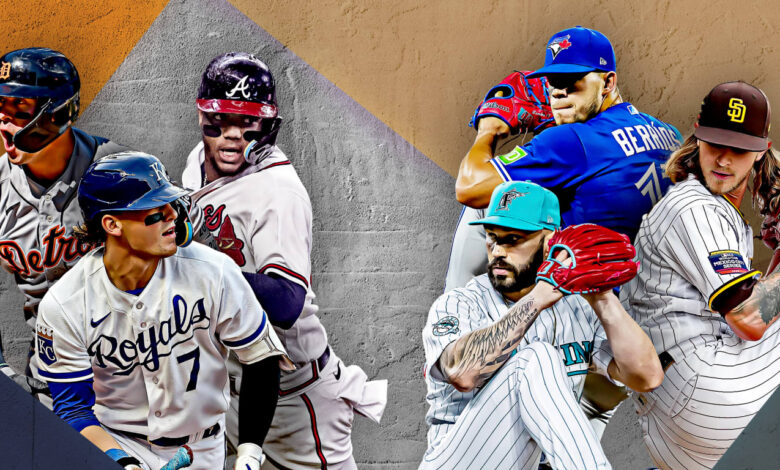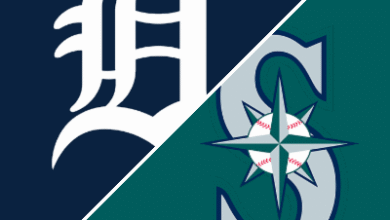They improved in ’23. What’s in store for ’24?

3:09 AM UTC
It’s officially a new year, and with Spring Training fast approaching, most players have long since isolated the adjustments they’re hoping to make for 2024, whether that takes the form of better plate discipline, generating more swings and misses or hitting for more power.
It’s difficult to make a drastic change over the course of just one offseason, but each year, a select group of players do pull off that impressive feat. It’s always interesting to identify the effects of these adjustments — and wonder whether the players in question can maintain them moving forward.
Baseball Savant’s year to year changes leaderboard makes it even easier to pick out those who improved by leaps and bounds in at least one statistical category. Here are 10 notable examples from last season, each of whom will bring heightened expectations with them into 2024.
HITTERS
Ronald Acuña Jr., Braves
-12.2 points in strikeout rate (23.6% to 11.4%)
A year ago, you might have asked how Acuña could get meaningfully better. Even now it may not be entirely clear, because the video game numbers that made him the runaway NL MVP Award winner — he hit .337 with 41 home runs and 106 RBIs and led MLB in runs (149), hits (217) and stolen bases (73), putting up the first 40-70 season in MLB history in the process — have a way of masking them.
Acuña was already a powerhouse at the plate, but if he had any real shortcomings coming into the 2023 season, they came in the form of strikeouts. He posted a 23.6% strikeout rate in 2022. That was the worst of his career and also ranked in the 34th percentile of qualifying Major Leaguers. Owing in part to a 6.1-point drop in his whiff rate, Acuña’s K% dropped 12.2 points, the largest improvement made by any qualifier from 2022-23, landing him in the 97th percentile. That effectively made him the most complete position player in baseball last year, and could do the same next year.
Corey Seager, Rangers
+7.7 points in hard-hit rate (45.5% to 53.2%)
Last season, Seager played 119 games, limited by a left hamstring strain and a right thumb sprain. He also led the AL in doubles (42), matched his 2022 home run total (33) in 32 fewer games and was the runner-up in AL MVP Award voting to Shohei Ohtani, who won unanimously. For context, the last player to finish first or second in league MVP voting with as few games played in a 162-game season was George Brett in 1980.
Seager’s incredible rebound came from his dramatic improvement in hard-hit rate over the course of one offseason. His 53.2% hard-hit rate ranked in the 96th percentile in 2023, bumping his barrel rate up to the 92nd percentile despite his sweet-spot rate remaining roughly the same. For Seager, sustaining anything near that type of production for 2024 is likely to come down to continued work on two other areas of his game that improved alongside his hard-hit rate — those being his chase rate (-2.4 points from 2022) and whiff rate (-1.5 points).
Matt Olson, Braves
+90 points in xSLG (.467 to .557)
In 2023, Olson had 21 more plate appearances than he had in 2022 — and hit 20 more home runs. The 54 homers and 139 RBIs he accumulated both led baseball, his .604 slugging percentage led the National League, and his OPS was also up a staggering 191 points from 2022 (.802 in ’22, .993 in ’23).
Expected slugging percentage (xSLG) is based on a hitter’s quality of contact and strikeouts, and Olson’s hard-hit rate in 2023 was up 4.6 points from the year before. But that took him from the 96th percentile to the 99th among qualifying hitters, and he averaged 39 home runs per 162 games from 2016-22, so a lack of power has clearly never been his issue. But crucially, Olson appeared quite a bit more selective in 2023 — his chase rate dipped 2.5 points, his first pitch swing rate by 5.6 points, and his overall swing rate by 2.7 points.
Bobby Witt Jr., Royals
+106 points in xSLG (.427 to .533)
Witt spent the 2022 season ironing out the kinks so he could spend 2023 raking. And did he ever — in his age-23 season, Witt, the fastest player in baseball by sprint speed (30.5 ft/sec), finished seventh in AL MVP voting after recording the Royals’ first 30-30 season (30 HR, 49 SB).
The 106-point improvement in his xSLG — the fourth-largest in baseball — came down to a slight uptick in sweet-spot rate (+1.9 points) and a big step forward in hard-hit rate (+7.0 points). But resuming the trend in the right direction is likely going to depend heavily on continued improvement to his chase rate, which fell from 34.7% (16th percentile) to 30.6% (35th) between his rookie and sophomore seasons.
Spencer Torkelson, Tigers
+5.7 points in barrel rate (8.4% to 14.1%)
The Tigers decided to launch Torkelson’s Major League career in 2022. It didn’t go to plan — in 110 games he posted a .319 SLG and 74 OPS+ and hit just eight home runs — and the hiccup in his development raised questions about his immediate future. Major concerns were put to rest when Torkelson appeared to right the ship in 2023 with a .446 SLG, 105 OPS+ and 31 home runs across 159 games, becoming the youngest Tiger to record a 30-HR season since Matt Nokes did so in his own age-23 season in 1987.
Torkelson hit 62 barrels last season, tied for the seventh-most in MLB. His 5.7-point bump in barrel rate was the third-largest in 2023 and resulted from cutting his ground-ball rate (from 40.7 in 2022 to 33.9% in ’23) and increasing his hard-hit rate by 9.1 points (taking him from the 61st percentile to the 94th). Detroit showed real promise last season, but with offense ever at a premium in the AL Central and the Tigers themselves scoring the third-fewest runs per game in 2023 (4.08), taking another step forward in 2024 is going to rely heavily on its young hitters — Torkelson chief among them — building on that promise.
Cody Bellinger, free agent
-7.1 points in whiff rate (27.2% to 20.1%)
Bellinger averaged 37 homers per year in his first three Major League seasons, culminating in his winning the 2019 NL MVP Award with a 47-HR performance. He then posted a collective .203 average and 76 OPS+ from 2020-22. That’s the kind of dramatic skid a lot of players don’t come out of, but Bellinger did — by becoming a contact hitter.
Bellinger posted the worst hard-hit rate of his career to date in 2023 (31.4%, 10th percentile), which sounds like bad news, but the 7.1-point improvement to his whiff rate was the second-best in MLB and brought him into the 77th percentile among Major Leaguers. That alone was largely responsible for his huge comeback that he ended with a .307 AVG and 133 OPS+, and while it was an unusual year by his standards, he still hit 26 home runs, tied for the Cubs team lead with Christopher Morel. That performance was worth league-wide recognition, as he at long last won his second Silver Slugger Award and finished 10th in NL MVP voting. Where Bellinger goes from here is anyone’s guess at this point, but wherever he lands this offseason, keeping his swings and misses to a minimum should remain the top priority.
PITCHERS
Tanner Scott, Marlins
-8.1 points in walk rate (15.9% to 7.8%)
Everything came together for Scott in 2023, but a drastic reduction in walks — the largest among qualifying pitchers — made the biggest difference. Scott recorded 6.6 walks per nine and a 1.96 strikeout-to-walk ratio in 2022; last season, he ended with 2.8 BB/9 and 4.33 K/BB. That, naturally, kept the bases clearer — his WHIP fell from 1.61 to 0.99 — and he lost two full runs off his ERA (4.31 to 2.31).
There’s no need to over-complicate this adjustment; he spent more time around the strike zone. Scott throws a slider and a four-seam fastball; by dropping his slider usage by about 10 points and throwing his four-seamer in the zone (57.3% of the time, compared to 43.4% in 2022), he improved his overall in-zone rate by 5.7 points. His first-pitch strike rate rose 15.2 points, which also made an enormous difference, given that opposing hitters slashed .267/.415/.373 after 1-0 counts and .149/.189/.183 after falling behind 0-1 against him. The Marlins, after reaching the postseason last year, are no doubt hoping to do better than an 84-78 record and quick Wild Card Series exit in 2024 — which would be a lot easier if the backbone of their 2023 bullpen appeared in the same form.
Hector Neris, free agent
-16.7 points in hard-hit rate (44.7% to 28.0%)
Neris’ was the largest drop in hard-hit rate among qualifying pitchers and was largely responsible for his ERA improving from 3.72 in 2022 to 1.71 in ’23. Opposing batters hit just .174 against him, down from .205 in 2022.
That being said, it is worth noting his 3.33 expected ERA — which showed little improvement from the 3.29 xERA he recorded in 2022 — and the likelihood that some of his improvement has to be chalked up to him throwing fewer strikes altogether. While not exactly new for him, Neris’ command issues were more pronounced last season (his 11.4% walk rate ranked in the 12th percentile), and while the poor contact he generated limited the damage against him, it’s difficult to say one way or another how 2024 will go for the veteran right-hander.
José Berríos, Blue Jays
-8.0 points in hard-hit rate (43.8% to 35.8%)
Berríos had by far his worst full season in 2022, posting a 5.23 ERA and an 11th percentile hard-hit rate on the way to giving up the most hits and earned runs in the AL. The issue was difficult to pin down and left the Blue Jays with a recently acquired pitcher who was still throwing strikes and whose stuff hadn’t suffered but who wasn’t getting the job done all the same.
After an offseason spent working on his mechanics, the 2023 iteration of Berríos bore a striking resemblance to the guy Toronto had traded for. His hard-hit rate dropped to its lowest since the 2019 season, ranking in the 73rd percentile, and his overall numbers looked quite a lot more like those he’d put up from his first full season in 2017 through 2021.
2017-21: 3.74 ERA, 1.17 WHIP, 7.9 H/9, 9.2 K/9
2022: 5.23 ERA, 1.42 WHIP, 10.4 H/9, 7.8 K/9
2023: 3.65 ERA, 1.19 WHIP, 8.2 H/9, 8.7 K/9
With uncertainty still hanging around Alek Manoah, a reliable Berríos would mean a lot to a Blue Jays team coming off another ultimately disappointing year.
Josh Hader, free agent
-130 points in xSLG (.359 to .229)
Hader got knocked around in an unusually brutal 2022 season. He then spent the winter making some major adjustments, and returned to elite form largely without issue.
Hader’s staggering 130-point improvement in xSLG against him was the largest year-over-year improvement across baseball by a mile — the second-largest belonged to Ryan Brasier, whose xSLG dropped by 87 points). It came as a result of drastic improvements to his hard-hit (-8.0 points) and sweet-spot rates (-11.5 points, T-2nd in MLB); 30.1% of batted balls against Hader in 2022 were line drives compared to just 20.4% in 2023. Just a year after posting a career-worst 5.22 ERA, he made a strong case for himself entering free agency with a 1.28 ERA and 85 strikeouts in 56 1/3 innings.



